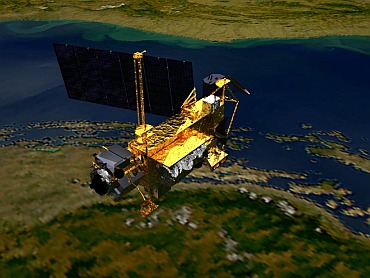An amateur astronomer has recorded images of the doomed National Aeronautics and Space Administration satellite as it tumbles back to earth and is expected to crash on or around September 24.
Astrophotographer Thierry Legault's footage shows the six-tonne, 20-year-old Upper Atmosphere Research Satellite (UARS), appearing as a beaming mass of light as it plummets to earth.
Legault captured the video as the satellite passed over northern France on September 15, the BBC reported.
...
WATCH: Doomed NASA satellite captured on video
Image: This conceptual image shows the Upper Atmosphere Research Satellite, launched on September 15 1991 by the space shuttle DiscoveryPhotographs: NASA
Legault, who posted the footage on his Astrophotography website, said he used a specially designed camera to record the tumbling satellite through his 14-inch telescope.
Though scientists still cannot predict precisely when or where it will strike, NASA said UARS could land anywhere between 57 degrees north and 57 degrees south of the equator -- most of the populated world.
However, there is a one in 3,200 chance that it could hit someone, the US space agency said. Although it's expected that most of the satellite will break or burn up before reaching Earth, scientists said they have identified 26 separate pieces that could survive the fall through the atmosphere.
...
WATCH: Doomed NASA satellite captured on video
Image: The Upper Atmosphere Research SatellitePhotographs: NASA
This debris could rain across an area 400-500km (250-310 miles) wide. Robust, spherical satellite components such as fuel tanks are often most likely to survive the fiery plunge to Earth, they said.
The "productive scientific life" of the $750-million satellite, which was launched in 1991 to study the ozone layer and the Earth's upper atmosphere to better understand their role in the planet's climate, ended in 2005 when it ran out of fuel.
According to NASA, scientists would only be able to make accurate predictions about where the satellite might land two hours before it enters the Earth's atmosphere.



article